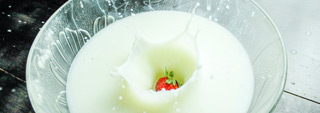Dairy milk and alternative milks are, you might say, as different as chalk and cheese. But are they?
In actual fact, they do have something in common. Cheese is made from dairy milk, which contains calcium and chalk is a type of inorganic calcium, called calcium carbonate.
The difference is that calcium carbonate is an unnatural ingredient. You will find it in the chalk used on blackboards and in shells and wouldn’t imagine putting it in your mouth. However, calcium carbonate is used regularly in food supplements, as a filler in pills and as an antacid. But excessive consumption can be hazardous and cause poor digestion.
That is why I was surprised to discover that it features in many alternative milks, which people probably consume regularly. I’m an alternative milk drinker myself and have done quite a lot of research into them.
Milk is good for you
First, let’s look at the positives of milk, before getting down to the nitty gritty on calcium. A glass of cows’ milk provides around 300mg of calcium, 400mg of potassium and 12g of sugar in the form of lactose. So, it’s a good source of nutrition and great for bone health.
But for people who are lactose intolerant, dairy milk has to be avoided as it causes bloating, gas and general stomach discomfort. So, an alternative is better for them and, of course vegans. Also there are those who feel that alternative milks are simply more healthy.
Certainly, the advertising would lead you to believe that they are. Some manufacturers claim that their milks contain 50% more calcium. But it’s important to take other ingredients into account. Rice milk, for example, contains twice as many carbohydrates as cows’ milk and hardly any protein. Almond milk, the favoured choice of many, has a good supply of protein, fibre, calcium, vitamin E and healthy fats. The only downside is that a lot of the goodness doesn’t end up in the end product. This is due to the milling and the way it’s processed. Plus, if you have a nut allergy, it’s not for you.
Oat milk is good generally and well tolerated, although it may contain some gluten.
Calcium carbonate is not natural
Now, let’s get to the main point. Like many of you, I try and eat as healthily as possible. But, just when I found an alternative milk that I really liked, I discovered, on calling the company, that it contained calcium carbonate.
As well as being an inexpensive way of fortifying alternative milk with calcium, it also serves to make it white. Some companies will list calcium carbonate in the ingredients on their labelling. But other’s will not. I wonder why?
Well, only the other day I rang one of the manufacturers and asked, “why are you putting chalk in your milks?” They didn’t have an answer other than to confirm that they do add calcium carbonate.
Manufacturers will argue that calcium carbonate offers consumers as much readily-absorbable calcium and provides the same level of bone protection as that naturally-occurring in dairy milk. This was was stated in the American Journal of Clinical Nutrition back in 2005.
Chalk leaves deposits
As I said earlier, consuming chalk is not natural. No doubt this is why it can have a negative impact in the long run. If you are consuming alternative milks containing calcium carbonate on a regular basis, you need to be aware that chalk deposits can build up and, worse case scenario, clog the arteries. Calcium carbonate may also cause acid rebound. The stomach will overcompensate for the high dose of calcium carbonate – which is alkaline – by churning out more acid. For that reason, people with a history of stomach ulcers are advised that they may not tolerate it.
I realise that all this sounds depressing, especially if you are lactose-intolerant, vegan or just wanting to find healthy food options. The good news is that there are some alternative milks that do not contain calcium carbonate and will support your dietary aims.
If you are unsure, or the label is not clear, then call the manufacturer and ask them if their product contains calcium carbonate. Obviously, you may feel that you need additional calcium. In that case, I would advise taking a ‘food state’ supplement – one that is made from actual food. Native Elements, for example, is made from high calcium yeast.
While there is nothing better than food itself for getting the calcium that the body needs, sometimes we do need a bit of extra help and support.
The message is to always check the labels.
If you have found this article useful, please feel free to share it.

